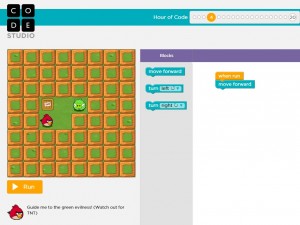Kindergartners and first graders crowded into the Susitna Elementary computer lab Monday morning. But they’re not playing computer games — they’re learning to write them during an Hour of Code.
Kindergartner Addison Perry peers through her glasses at the computer screen. In the corner is a picture of a video game — blocks and grass patches form a maze.
“I’m moving the red bird,” she explains. “I’m moving it to the green pig.”
Addison is using a simplified version of block coding to control the characters from Angry Birds. She pieces together lines of code that say “move forward” or “turn left.” She has to put the codes in the right order to navigate the little red bird around a corner, but she gets frustrated.

“I don’t know which way he should go. I don’t know it’s left or right. It’s not telling me.”
For the next few minutes we talk about left and right and how it changes depending on the direction you face. We count blocks on the screen and Addison decides what order to place the commands. We’re interrupted by another student with a common complaint.
I’ve been “waiting for like two minutes and it’s still not going,” he says when pointing at the white computer screen with a tiny turning wheel. His is not the first to get stuck that day.
“So what we’re going to do is reload the page,” I explain.
The web page is moving very slowly because millions around the world are trying to access it. The students are participating in the Hour of Code, a week-long event that debuted last year from the organization code.org. The project uses hour-long tutorials featuring popular characters like the Angry Birds or Elsa and Anna from Frozen to teach students how to code computer programs. More than 52 million people are participating worldwide from 180 countries.
“There’s children in Africa, South America…” teacher Lucinda Eliason Jensen starts to explain. The kids jump in.
“Asia!”
“California!”
“South Dakota!!”
And nearly 100 schools and libraries are participating in Alaska. Jensen helped coordinate the project for Susitna Elementary in East Anchorage.
“Coding is becoming one of the fastest growing fields in America, and there’s a shortage of programmers right now. So we decided to jump on the boat and get these kids ready.”
Jensen says the program teaches them math skills, geometry, and spatial relationships. And it’s a chance for parents to get involved both in school and at home.
Marnie Kaler is sitting next to her son Katahdin giving pointers.
“Well, wait. He’s moving forward two times,” she says as she points at the screen. “Do you need to turn him?”
Kaler says she was immediately sucked in. “Super excited. Super excited. Like this is the coolest program ever.”
Kaler says the program teaches about more than just computers.
“I think that having the ability to code will help him go further. I think having that understanding of sequential type problems will help him go further in math and in other subjects.”
Across the room, Addison is finished writing her code. She clicks on “Run” and hears clicks and cheer. She successfully wrote code to move the red bird around two corners to capture the evil green pig.
Anne Hillman is the healthy communities editor at Alaska Public Media and a host of Hometown, Alaska. Reach her at ahillman@alaskapublic.org. Read more about Anne here.





